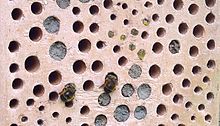Common hole bee
| Common hole bee | ||||||||||||
|---|---|---|---|---|---|---|---|---|---|---|---|---|

Common holey bee ( Heriades truncorum ) |
||||||||||||
| Systematics | ||||||||||||
|
||||||||||||
| Scientific name | ||||||||||||
| Heriades truncorum | ||||||||||||
| ( Linnaeus , 1758) |
The common holey bee ( Heriades truncorum ) is a species of holey bees ( Heriades ) in the family (Megachilidae).
features
The bees are six to eight millimeters long. They cannot be distinguished from Heriades crenulatus and Heriades rubicola in the field . They have a black base color and have narrow, white hair fringes on the rear edges of the tergites . Their bodies are slightly shorter and more compact than that of scissor bees ( chelostoma ). Your head is pointed with the mandibles. The drones have a curved abdomen end.
distribution and habitat
The species is widespread in Europe and occurs in the Alps up to 1600 m above sea level. Above all, forest edges and clearings, orchards with old trees, hedges, old vineyards and woods are settled. The species also occurs in gardens. Unlike the other two representatives of its genus in Central Europe, it has less heat requirements and is therefore more widespread and occurs frequently.
Way of life
The females lay their nests in dead wood, for example in old insect-feeding tunnels or in hollow plant stems, especially blackberries . They also accept artificial nesting aids, such as holes in wood and stalks of reeds and bamboo or nesting bricks made of clay. They prefer an inside diameter of 3 to 3.5 mm. In the nest, one to ten, usually four, brood cells are laid out one behind the other, the partitions of which are made of resin from coniferous and deciduous trees. During a single collective flight they collect of different types and are not limited to single ones. The bees fly an average of 34 collective flights per cell. The animals collect nectar and pollen oligolektisch of composite flowers (Asteraceae) and this plant family are detected in very many ways. However, they prefer yarrow ( Achillea ), wild flowers ( Tanacetum ), Alante ( Inula ) and ox eyes ( Buphthalmum ).
They fly in one generation per year from mid-June to mid-September, with the main activity from early July to late August, and in favorable years also until the end of September. The males do not fly as long as the females. The wintering takes place as a resting larva in the cocoon.
As a cuckoo bee , the kind parasitized is Stelis breviuscula known also it is from the leg wasp Sapygina decemguttata parasitized.
Individual evidence
- ^ A b c Andreas Müller, Albert Krebs, Félix Amiet: Bees. Central European species, way of life, observation . Naturbuch Verlag, Augsburg 1997, ISBN 3-89440-241-5 , p. 240 .
- ↑ a b Hole bees: Heriades truncorum . H.-J. Martin & Partner: www.wildbienen.de, accessed on May 17, 2015 .
- ↑ a b c d e f Paul Westrich : The wild bees of Baden-Württemberg. Special Part: The Genera and Species . Eugen Ulmer GmbH & Co, Stuttgart 1989, ISBN 3-8001-3307-5 , p. 651 f .
literature
- Andreas Müller, Albert Krebs, Félix Amiet: Bees. Central European species, way of life, observation . Naturbuch Verlag, Augsburg 1997, ISBN 3-89440-241-5 .
- Paul Westrich : The wild bees of Baden-Württemberg. Special Part: The Genera and Species . Eugen Ulmer GmbH & Co, Stuttgart 1989, ISBN 3-8001-3307-5 .
Web links
- Heriades truncorum at Fauna Europaea. Retrieved May 17, 2015

